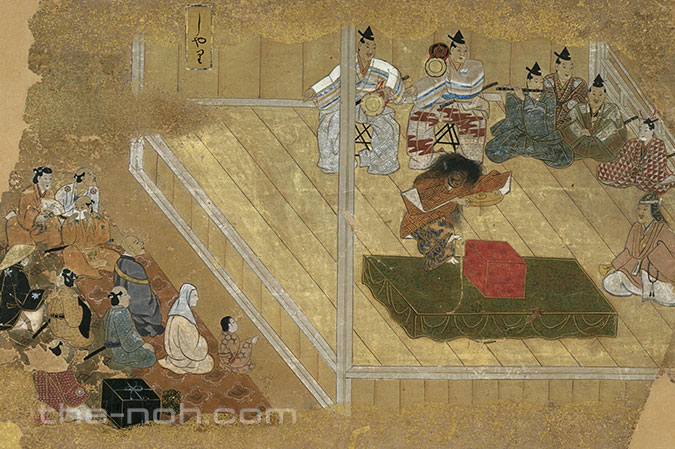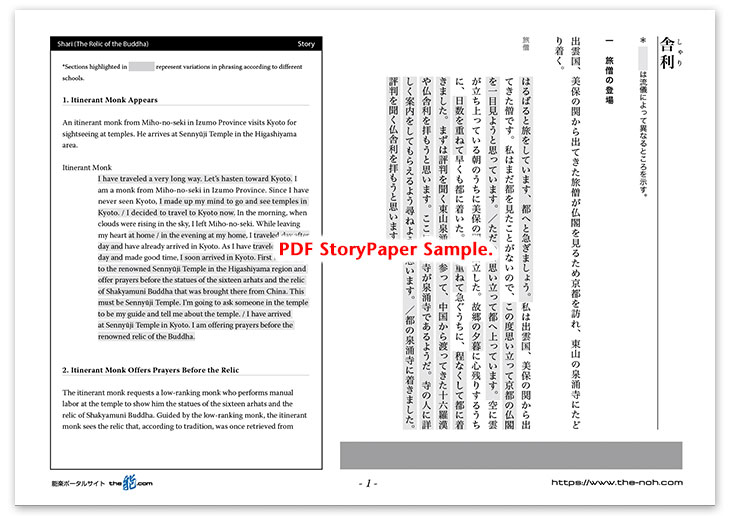
 Shari (The Relic of the Buddha)
Shari (The Relic of the Buddha)

![]()
An itinerant monk travels from Miho-no-seki in Izumo Province to Kyoto to do some sightseeing in the capital city. He visits Sennyūji Temple, in the Higashiyama area, to offer prayers to the sixteen arhats and a relic of the Buddha. Guided to the relic by a low-ranking monk who performs manual labor at the temple, the itinerant monk is so moved by seeing the Buddha’s relic that he sheds tears. When the itinerant monk is chanting a sutra in front of the relic, a villager who lives near the temple appears and joins the monk in offering prayers before the Buddha’s relic. While the villager is recounting the history of the relic, the sky suddenly turns dark and thunder starts to rumble. The villager then reveals that he is a rakshasa demon. He steals the relic, kicks apart the ceiling, flies through the sky, and disappears.
Alarmed by the commotion, the low-ranking monk comes in. The itinerant monk explains to him how the rakshasa took the Buddha’s relic and ran away with it. The low-ranking monk tells the itinerant monk the story behind the relic and together, they invoke the heavenly deity Skanda. Then Skanda appears and chases the rakshasa through the sky, running the demon down to earth and finally retrieving the relic from him. The captured rakshasa, having lost his supernatural powers, vanishes.
![]()
The main theme of this play, the rakshasa and Skanda’s fight over the Buddha’s relic, is based on an anecdote described in Taiheiki (Chronicle of Great Peace) and other texts. The incident in question occurred in the time shortly after Shakyamuni Buddha passed away. In this play, it is reenacted with the setting having been moved to Sennyūji Temple in Japan. Although rakshasas are also called “fast-footed demons,” this one is caught by the heavenly deity Skanda, who runs even faster than the swiftly running demon. Of course, a demon who praises Shakyamuni Buddha and his relic is not entirely unlikable.
In the first half of this play, shite appears as a villager and does not move much. However, in the scene in which he reveals his identity as a rakshasa demon, his actions are vigorous and rough. He suddenly leaps up, steals the relic, dashes off, and stomps apart the floor of a stage prop in the form of a stupa. In the second half of the drama, the scenes in which Skanda is in pursuit of the rakshasa continue, and a stage prop, ichijō-dai, is effectively used to express, on the stage, the vast space of heaven and earth. Another interesting feature of this play is how the music changes along with the agile movements of the actors.
STORY PAPER : Shari (The Relic of the Buddha)
Story Paper presents noh chant stories in modern speech, with story outlines, highlights and more using Adobe PDF format, which can print out and zoom in. Print out the pages and take them with you when you see the actual noh performance.

The copyright of Story Paper is held by the Noh.com. Story Paper is for individual use only. It is prohibited by the copyright law to distribute or publish printed-out Story Paper pages without prior consent. For more information, check the credit and disclaimer pages.



 [Shari (The Relic of the Buddha) : Story Paper PDF : 486KB
[Shari (The Relic of the Buddha) : Story Paper PDF : 486KB